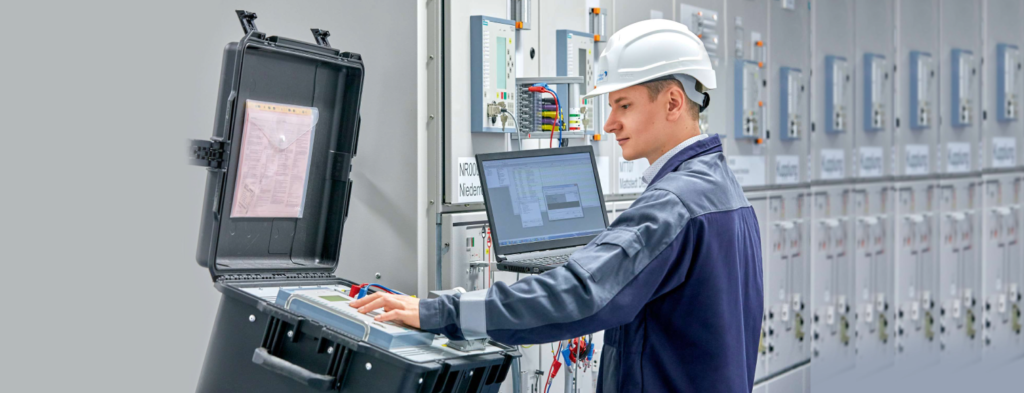RELAY COORDINATION STUDY
 Relay coordination study is a well-known fact that the power system is not completely free from failures/faults. The key here is to mitigate the consequences during the event of faults. Damage of equipment during a fault can be reduced by quickly isolating the faulty portion from rest of healthy system. The objective of relay coordination study is to determine optimum settings for protection devices such that protection system isolates the minimum possible faulty portion at the earliest possible in order to ensure the reliable power supply for the healthy system. The optimum settings ensure required sensitivity and selectivity that protect workers from harm as well. The software’s used for protection coordination study is ETAP, DigSilent Powerfactory, PSCAD, PSS/E. The relay coordination study involves protection devices from various manufacturers such as Siemens, ABB/Hitachi, GE, Schneider and so on.
Relay coordination study is a well-known fact that the power system is not completely free from failures/faults. The key here is to mitigate the consequences during the event of faults. Damage of equipment during a fault can be reduced by quickly isolating the faulty portion from rest of healthy system. The objective of relay coordination study is to determine optimum settings for protection devices such that protection system isolates the minimum possible faulty portion at the earliest possible in order to ensure the reliable power supply for the healthy system. The optimum settings ensure required sensitivity and selectivity that protect workers from harm as well. The software’s used for protection coordination study is ETAP, DigSilent Powerfactory, PSCAD, PSS/E. The relay coordination study involves protection devices from various manufacturers such as Siemens, ABB/Hitachi, GE, Schneider and so on.
WHY RELAY COORDINATION STUDY?
- To determine the optimum settings for protective devices in the system such as relays, releases and breakers etc in order to ensure that proper coordination is achieved.
- To analyze time coordination curves (TCC) to verify the coordination between upstream and downstream protection devices including fuses.
- To check the sequence of operation of protection devices for various operating configurations.
- To find out the fault clearing time.
- To verify the protection coordination of existing plant especially when there is a change in the network connectivity or source fault level.
- To generate calculation and finalize the unit protection settings of generator, line, cable, transformer, motor, reactor and capacitor banks.
- As an input for the calculation of incident energy in Arc Flash Studies.
HOW RELAY COORDINATION STUDY ? (METHODOLOGY)
- Collection of inputs (SLD, equipment parameters – Voltage kV rating, Power MVA rating, Impedance, System fault level, X/R ratio, relay details, protection schematics etc.)
- Modelling in study software.
- Carry out the short circuit simulations for various system configurations (normal and contingency configuration)
- Generating TCC curves and determine the characteristics and optimum settings
- Verification of sequence of operation for different types of faults (3 Ph, SLG, L-L, L-L-N) at various locations.
- Generating relay setting tables/charts, relay settings soft file (parameterization) file.
- Submission of detailed report.
- Presentation of study findings.
OUTCOMES OF RELAY COORDINATION STUDY
- Detailed report explaining the input data, system configuration, observations and recommendations
- Fault currents at various buses and branches in the system.
- Relay setting charts/tables with optimum settings
- Time coordination curves
- Sequence of operation
- Relay setting soft file
- Input to Arc Flash Study
The main objective of protection coordination study is to isolate the faulty portion as quick as possible to minimize the severity of damage to the faulted portion and causing unnecessary damage to the healthy part of the system.
Protection coordination is the selection and setting of protective devices in order to isolate only the faulted portion of the system.
A proper protection coordination is an essential ingredient of a well-designed electrical protection system.
In the planning stage of a power system network, the design engineer should endeavor to frame a protection system that is very simple and also ensures safety, reliability, easy maintenance and economic considerations.
Relay coordination begins from the farthest downstream device and coordination must exist with all upstream protective equipment up to the utility’s last protection device or the plant’s main protection device.
The time current characteristics curve generated for each protection device must be set in order to have proper coordination with the upstream protection equipment and strike a perfect balance between equipment damage and service continuity.
Protection coordination focuses on obtaining selectivity to minimize the extent of equipment shutdown in case of a fault.
REFERENCE
- IEEE 242 – Recommended Practice for Protection and Coordination of Industrial and Commercial Power Systems
- IEEE 3004 Standards: Protection & Coordination
- IEEE 399 – Recommended Practice for Industrial and Commercial Power System Analysis
- IEEE 241 – Recommended Practice for Electric Power Systems in Commercial Buildings
- IEC 60255 Measuring relays and protection equipment
